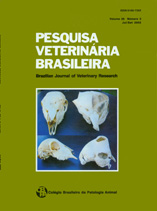 |
|
|
|
Year 2005 - Volume 25, Number 3
|

|
O Herpesvírus bovino tipo 5 (BoHV-5) pode utilizar as rotas olfatória ou trigeminal para invadir o sistema nervoso central de coelhos, dependendo da via de inoculação, p.164-170
|
Diel D.G., Fonseca E.T., Souza S.F., Mazzanti A., Bauermann F., Weiblen R. & Flores E.F. 2005. [Bovine herpesvirus 5 may use the olfactory and trigeminal pathways to invade the central nervous system of rabbits, depending upon the route of inoculation.] O Herpesvírus bovino tipo 5 (BoHV-5) pode utilizar as rotas olfatória ou trigeminal para invadir o sistema nervoso central de coelhos, dependendo da via de inoculação. Pesquisa Veterinária Brasileira 25(3):164-170. Departamento de Medicina Veterinária Preventiva, Universidade Federal de Santa Maria, 97105-900 Santa Maria, RS, Brazil. E-mail: flores@ccr.ufsm.br
Bovine herpesvirus type 5 (BoHV-5) is a major etiological agent of meningoencephalitis in cattle. Following replication in the nasal mucosa, viral invasion of the brain is thought to occur mainly by the olfactory pathway. To address the role of this pathway in the pathogenesis of neurological infection in a laboratory model, 30 days old rabbits had the main olfactory bulbs (MOBs) surgically removed and were subsequently inoculated intranasally (IN) or conjunctivally (IC) with a highly neurovirulent BoHV-5 strain (SV-507). Following IN inoculation, 10 out of 10 (100 %) control rabbits developed neurological disease. The clinical onset ranged from day 5 to 10 post-inoculation (pi, average 7.5 days); nine being euthanized in extremis and one recovering after a mild clinical course. In contrast, only one rabbit (9.1 %) of the group lacking the MOBs (n=11) developed neurological disease (onset at day 17 pi). Dexamethasone administration to the survivors (n=10) at day 50pi was followed by virus shedding in nasal and/or ocular secretions by 8 animals, demonstrating that the virus was able to reach the trigeminal ganglia (TG) during acute infection. These results demonstrate that the olfactory route provides the main, yet not the sole access to the brain of rabbits following IN inoculation. To address the role of a second pathway, groups of control (n=12) or MOB-lacking rabbits (n=12) were inoculated into the conjunctival sac (IC), following which the virus would be expected to use the ophtalmic branch of the trigeminal nerve to reach the brain. Ten control rabbits (83.3 %) developed neurological disease upon IC inoculation (onset 15.3 days [11 to 20]). Previous ablation of the MOBs did not affect the frequency and course of neurological disease: ten out of 12 rabbits (83.3 %) lacking the MOBs developed neurological disease (onset 9 to 15 dpi, average: 12.7 days) upon IC inoculation. These results demonstrate that both IN and IC routes may operate in the transport of BoHV-5 to the brain of experimentally infected rabbits, depending on the route of inoculation. IN inoculation results in a fast and efficient transport by the olfactory pathway, the trigeminal route providing an alternative, much slower and less efficient transport; IC inoculation results in efficient viral transport by the trigeminal route, yet with a delayed kinetics comparing to the transport provided by the olfactory pathway. |
| |
|
|
| |
|
 |